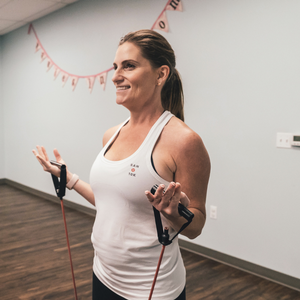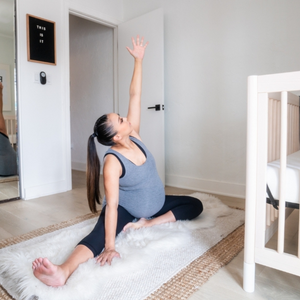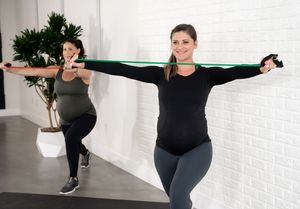
Training By Trimester: 4th Trimester
FIT4MOM x Jessica Maurer
Just like with every pregnancy, each 4th Trimester is unique. The 4th Trimester is the time between birth and being medically cleared for movement by your doctor. The 4th Trimester can last from six weeks up to three months. It fluctuates not based on how in shape you were before birth but on your ability to heal, rest, and recover.
Additionally, the six weeks after birth is the most intense for moms. Focus on keeping yourself and your baby healthy instead of worrying about returning to your fitness routine. You need to start slowly and listen to your body. You should approach movement in your 4th Trimester as a place of no judgment or comparison, just awareness. This experience is yours and yours alone! Every single pregnancy and birth is different, and everyone’s body will heal and recover differently. Celebrate this and honor it.
Life after the baby looks very different than life before the baby. If your workouts used to happen daily for an hour at a time, you’ll need to re-learn that everything counts, especially during the first few months. The goal of exercise during this time should be overall well-being, not your waistline. Movement should make you feel better, give you a chance to take a break from caring for the baby, and a time to connect to others. Every step counts.
You will probably hear this from everyone, but it can be hard to remember: This time is fleeting. Your baby will never be a newborn again! Getting back into shape will come. You should enjoy this time with the new baby - you have a lifetime to work out.
Let's dive into our Start, Stop, and Continue for fitness in the 4th Trimester—just as we did for 1st, 2nd, and 3rd Trimesters.
START
The American College of Obstetricians and Gynecologists, ACOG, recommends starting gentle movements for new moms because:
It boosts energy levels.
It promotes better sleep.
It relieves stress and helps regulate emotions.
It may be useful in preventing postpartum depression.
While some moms may be eager to resume their fitness routine, we want to emphasize the importance of taking it slow. Walking is an excellent way to reintroduce movement into your daily life, whether strolling around the house or walking up and down the street. Walk with friends, family, and neighbors; this social support is crucial during this trimester. You can walk with a stroller, baby-wearing, or alone if you have a trusted companion or partner to watch the baby.
These walks should not focus on time, power walking, or intensity. Instead, they gently remind the body of its natural ability to take one step after another. Your goal is to move forward physically and mentally at a comfortable pace.
If you’re able to walk outside, you'll also benefit from receiving vitamin D, which can boost your immunity and lift your endorphins. However, walking indoors around the house, especially while the baby is napping, is equally important during the fourth trimester.
Recent postpartum women should prioritize reconnecting with their breath because it offers numerous physical and emotional benefits during the postpartum period. Pregnancy and childbirth can lead to changes in breathing patterns and diaphragmatic function, making it essential to re-establish proper breathing techniques. Focusing on conscious and deep breathing can help reduce stress, anxiety, and postpartum depression, promoting emotional well-being. Moreover, deep breathing aids in core and pelvic floor muscle activation, supporting the recovery of these essential areas after childbirth. By reconnecting with breath, you can improve your body's healing process, regain strength, and enhance overall relaxation and mindfulness, fostering a healthier and more balanced postpartum experience.
Remember, the 4th trimester is a time of recovery and adjustment, so you must be kind to yourself and prioritize your well-being as you navigate this beautiful journey of motherhood.
STOP
Stop with any expectations of when you'll return to your previous fitness routines. Whether it was a vaginal or a C-section delivery, if you return to fitness too soon, you risk further damaging your pelvic floor, deepening your DRA, and causing other muscular or postural imbalances. All of these things have long-term negative effects.
After giving birth, the uterus sheds the thick lining that develops during pregnancy, leading to a natural discharge known as lochia. This discharge includes blood, mucus, and tissue, a normal part of the postpartum healing process. New mothers need to be aware of the characteristics of lochia, as it can provide insights into their recovery and overall well-being. Monitoring the amount and color of lochia can offer valuable information about a woman's postpartum healing progress. If the discharge suddenly increases in amount or becomes bright red after tapering off, it might be a sign that you are overexerting yourself and need to prioritize rest to support proper healing.
Certain positions are going to be uncomfortable for you in the 4th Trimester. For example, you should only be in a prone position while transitioning levels and not training there for extended periods. Seated positions may also be uncomfortable based on pelvic floor dysfunctions, hemorrhoids, or perineal tearing. You can aggravate your DRA, C-Section incision, and sensitive breasts by putting stress and weight on the front side of the body. Additionally, relaxin is still present in the body after delivery and can affect joint stability, potentially making certain positions less comfortable.
Let go of your assumptions of bouncing back and turn your focus to overall wellness—nutrition, hydration, rest, and intuitive movement.
CONTINUE
During the 4th Trimester, rest is paramount. This period represents a time of transition, where the demands of caring for a newborn can be overwhelming. You should prioritize self-care and allow yourself the space, grace, and time needed for recovery.
This might involve getting as much sleep as possible, accepting help from friends and family, and recognizing that feeling physically and emotionally drained during this phase is perfectly normal. Rest is not a luxury but a necessity, as adequate rest can play a pivotal role in the healing process, promote emotional well-being, and contribute to the ability to care for the newborn effectively.
As for returning to fitness, it's important to remember that there's no universal timeline for this. Every woman's body is different, and recovery from childbirth varies from person to person. The emphasis should be on listening to your body and seeking guidance from healthcare professionals. You may feel ready to engage in light physical activities like walking or gentle stretching relatively soon after giving birth, or you may need more time. The key is not to rush the process but to gradually rebuild strength and stamina at a comfortable and safe pace. It's essential to be patient and prioritize overall well-being over external pressures to "bounce back" quickly.
Do you want more information and guidance? Motherhood is a transformative journey filled with joy, challenges, and the need for incredible strength. Since 2001, FIT4MOM has been the leader of prenatal and postnatal fitness, supporting moms nationwide through our network of franchise owners and dedicated instructors. To further support our mission of helping all moms find their Strength in Motherhood®, we are thrilled to announce our first-ever certification course available to all fitness professionals: FIT4MOM’s Prenatal & Postnatal Fitness Certification.
Let's empower moms to find their Strength in Motherhood® and unlock their full potential for everyday life as a new parent. Motherhood is an extraordinary experience; with FIT4MOM, you can make it even more empowering for your clients.
WANT TO LEARN MORE?
Bringing new life into the world is a miraculous and life-altering experience, but it's no secret that pregnancy and postpartum can bring a whirlwind of changes to a woman's body. As a fitness professional or health enthusiast, you have the power to support and empower mothers on their journey to a healthy pregnancy, a smoother birth experience, and a robust postpartum recovery.
Register here to receive more information for training the female client.
WANT MORE, MAMA?
Other blogs about pregnancy you'll enjoy:





